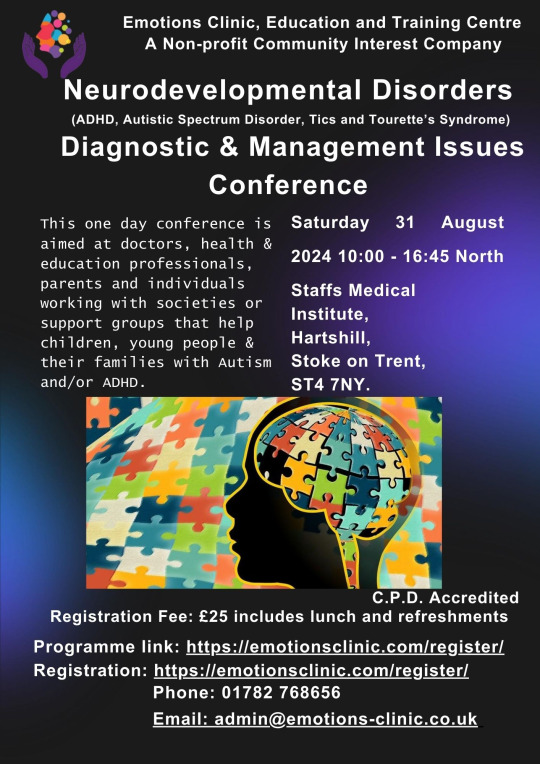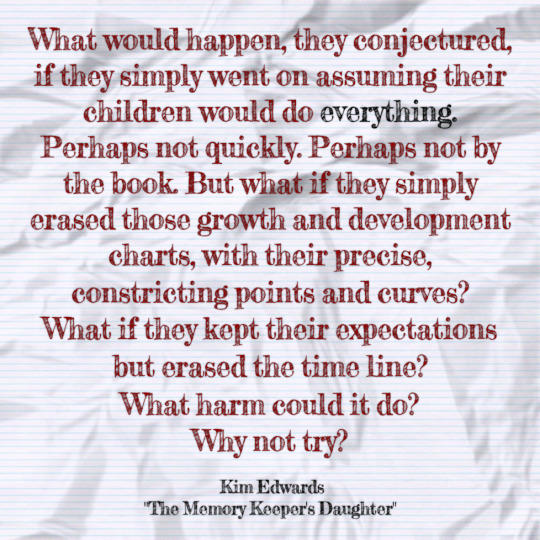#DevelopmentalDisabilities
Explore tagged Tumblr posts
Text
We are pleased to inform you that we are organising a one-day conference on Neurodevelopmental Disorders

We are pleased to inform you that we are organising a one-day conference on Neurodevelopmental Disorders (ADHD, Autistic Spectrum Disorder, Tics and Tourette’s Syndrome) on 31 August 2024 in Stoke on Trent. We look forward to welcoming you to this event in Staffordshire, England.
Programme Details: https://emotionsclinic.com/register/
Registration Fee: £25 includes Lunch and Refreshments.
Register here: https://emotionsclinic.com/register/
You can also register by contacting Emotions Clinic – Phone 01782-768656, Email: [email protected]
#Conference#Conference2024#NeurodevelopmentalDisorders#Neurodiversity#MentalHealthAwareness#DevelopmentalDisabilities#DisabilityAwareness#NeurodevelopmentalDisordersAwareness#EmotionsClinic
0 notes
Text
In the realm of Applied Behavior Analysis (ABA), the Verbal Behavior Milestones Assessment and Placement Program (VB-MAPP) is an invaluable tool. Developed by Dr. Mark Sundberg, the VB-MAPP is widely used to assess language and social skills in individuals with autism and other developmental disabilities. However, the unauthorized distribution and use of VB-MAPP PDFs has become a significant issue, raising concerns about intellectual property rights and ethical practices. This blog explores the importance of protecting intellectual property, the specific case of VB-MAPP PDFs, and the broader implications for the ABA community.
#VBMAPPIssues#IntellectualPropertyRights#ABACommunity#AutismAssessment#DevelopmentalDisabilities#EthicalPractices#CopyrightProtection#ABAProfessionalism#DrMarkSundberg#BehaviorAnalysis
1 note
·
View note
Text
#DevelopmentalDisabilities#AutismAwareness#IntellectualDevelopment#InclusiveEducation#DisabilitySupport
0 notes
Text
Following the Client's Lead, Day 1
youtube
#behavior#behavioralhealth#DIR#attention#growth opportunities#development#developmentaldisabilities#mental health#mental health matters#asd#adhd#sensory#sensory processing#sensory processing disorder#sensory overload#neurodivergent#neurodiverse#parenting#emotional regulation#Youtube
0 notes
Text

Join the T2000 Team for Pediatric Physical Therapy (PT) Jobs in Texas. Make a Positive Difference in Kids' Health. Apply for PT opportunities now!
#pediatrictherapyjobs#therapyjobs#occupationaltherapy#occupationaltherapyathome#pediatricspeechtherapy#childrensphysicaltherapyjobs#developmentaldisabilities
0 notes
Text
#dyscalculia#dyscalculiachild#developmentaldisabilities#developmentaldisability#parentingtips#parentingguide#specialneeds#specialneedsparenting#specialneedskids
0 notes
Text


DISABILITY PRIDE MONTH QUOTE 9 OF 9 Thursday, July 13, 2023
What would happen, they conjectured, if they simply went on assuming their children would do everything. Perhaps not quickly. Perhaps not by the book. But what if they simply erased those growth and development charts, with their precise, constricting points and curves? What if they kept their expectations but erased the time line? What harm could it do? Why not try? - Kim Edwards, The Memory Keeper's Daughter
~~~~~~~~~~~~~~~~~~~~~~~~~~~~~~~~~~~~
Check out Diversability, founded by Tiffany Yu, for educational resources! The image was made with and, initially, shared via the Quotes Creator App to Instagram; check it out here! Interested in seeing where the quote came from? If so, click here! Watch MonriaTitans on Twitch and YouTube!
#kimedwards#thememorykeepersdaughter#disabilitypridemonth#educational#antiabelism#chronicillness#disabled#disability#developmentaldisability#downsyndrome#growthanddevelopment#intellectualdisability#disabledisnotabadword#kimedwardsquote#kimedwardsquotes#quotesaboutdisabilities#abelism#educationalpost#educationalposts#learnsomethingneweveryday#becomesmartereveryday#becomempowered#bempowering#monriatitans#wgs#monriatitanswgs#diversability#quotescreatorapp#affiliatelink#bookshoporg
0 notes
Link
🧩 Autism is a complex neurodevelopmental disorder that affects millions of people worldwide. While some individuals with autism are high-functioning and able to live independently, others require more support to navigate daily life. Low functioning autism is a term used to describe individuals who require significant assistance with communication, social interaction, and daily living skills. 🧩 Understanding low functioning autism is crucial for parents, caregivers, and educators who work with individuals on the autism spectrum. These individuals may struggle with sensory processing, communication, and emotional regulation, making it difficult for them to navigate social situations and daily life. It's important to recognize that each person with autism is unique and may require different levels of support. 🧩 Early intervention and individualized treatment plans can help individuals with low functioning autism reach their full potential. While there is no cure for autism, therapies such as speech and occupational therapy, behavioral interventions, and medication can help individuals with autism develop the skills they need to thrive. By understanding the challenges faced by individuals with low functioning autism, we can work to create a more inclusive and supportive society for all.1. What is Low Functioning Autism and How is it Diagnosed?Low functioning autism is a severe form of autism that affects a person's ability to communicate, socialize, and perform daily activities. It is diagnosed based on specific criteria, including impaired social interaction, communication, and repetitive behaviors. To diagnose low functioning autism, doctors use a combination of methods, including observation, interviews with parents and caregivers, and standardized tests. They may also use medical tests to rule out other conditions that may cause similar symptoms. Symptoms of low functioning autism may include delayed speech, lack of eye contact, repetitive behaviors, and difficulty with social interactions. These symptoms may be present from early childhood and may become more severe over time. Early intervention is crucial for children with low functioning autism. Treatment may include behavioral therapy, speech therapy, and medication to manage symptoms. It is essential to work with a team of healthcare professionals to develop a personalized treatment plan. Living with low functioning autism can be challenging, but with the right support and resources, individuals with this condition can lead fulfilling lives. It is essential to focus on their strengths and abilities rather than their limitations. 🧩🧠👥🏥👨⚕️👩🏫👩🔬👨🔬📈📊📚📝🎓🧑🎓🌟2. Understanding the Symptoms and Behaviors of Low Functioning AutismLow functioning autism is characterized by severe impairments in communication, social interaction, and behavior. Individuals with this condition may exhibit the following symptoms and behaviors: Delayed or absent speech Difficulty understanding social cues Repetitive behaviors and routines Aggressive or self-injurious behavior Difficulty with fine and gross motor skills Individuals with low functioning autism may also have intellectual disabilities and require significant support to perform daily tasks. It is important to note that each person with low functioning autism is unique and may exhibit different symptoms and behaviors. It is essential to work with a healthcare professional to develop a personalized treatment plan. Early intervention and therapy can help improve communication, social interaction, and behavior in individuals with low functioning autism. It is also important to provide a structured and predictable environment to help reduce anxiety and promote learning. With appropriate support and understanding, individuals with low functioning autism can lead fulfilling lives and achieve their full potential. 🧩👨👩👧👦👩🦽🧠3. The Importance of Early Intervention for Low Functioning AutismEarly intervention is crucial for low functioning autism. It can improve cognitive, social, and communication skills. It can also reduce challenging behaviors and increase independence. Interventions should be individualized and evidence-based. Applied Behavior Analysis (ABA) is a commonly used intervention. Speech and language therapy and occupational therapy can also be beneficial. Parents and caregivers play a vital role in early intervention. They should be involved in the intervention process and receive training. Early intervention can also improve the quality of life for the whole family. Early intervention can lead to better long-term outcomes. It can increase the likelihood of independent living and employment. It can also reduce the need for special education and support services. Don't wait, seek early intervention for low functioning autism. 👍🏼4. Strategies for Supporting Individuals with Low Functioning AutismIndividuals with low functioning autism require specialized support to thrive. Here are some strategies: Establish a predictable routine to reduce anxiety. Use visual aids such as pictures and schedules to aid communication. Provide sensory input through activities like brushing or deep pressure. Teach social skills using role-playing and video modeling. Implement positive reinforcement to encourage desired behaviors. It's important to tailor strategies to meet the individual's unique needs and abilities. Consider the individual's sensory preferences when selecting activities. Use clear and concise language when giving instructions. Encourage independence by breaking tasks into smaller steps. Collaborate with parents and caregivers to ensure consistency across settings. Monitor progress and adjust strategies as needed. Remember, individuals with low functioning autism have strengths and abilities. Identify and build on these strengths to increase confidence. Provide opportunities for the individual to engage in preferred activities. Encourage participation in community activities to promote socialization. Offer support for transitions and changes in routine. Be patient and understanding, and celebrate small successes. By implementing these strategies, individuals with low functioning autism can lead fulfilling and meaningful lives. 🌟5. Common Challenges and Misconceptions Surrounding Low Functioning Autism🤔 Low functioning autism is often misunderstood. Here are some common misconceptions and challenges: Assumption of low intelligence: People with low functioning autism may have difficulty communicating, but they are not unintelligent. Difficulty with social interaction: Low functioning autism can make social interactions challenging, but it doesn't mean they don't want to connect with others. Behavioral issues: People with low functioning autism may exhibit challenging behaviors, but it's important to understand the underlying cause and not just label them as "bad." Limited communication: Communication can be difficult for those with low functioning autism, but it's important to find alternative ways to communicate. Need for routine: Routine is important for those with low functioning autism, but it's important to find a balance between structure and flexibility. 👉 Understanding and acceptance can go a long way in supporting those with low functioning autism. Educate yourself and others to break down misconceptions and create a more inclusive society.6. Navigating Educational and Therapeutic Services for Low Functioning AutismWhen , it's important to: Research and compare programs Visit potential schools and providers Ask for referrals and recommendations Consider the level of support offered It's also crucial to: Ensure the program is evidence-based Check staff qualifications and training Ask about communication methods Consider the location and transportation options Therapeutic services may include: Occupational therapy for sensory integration Speech therapy for communication skills Applied Behavior Analysis (ABA) for behavior management Physical therapy for motor skills Educational services may include: Individualized Education Plans (IEPs) Special education classrooms Behavioral intervention plans Assistive technology and devices It's important to: Stay involved and informed Communicate regularly with providers Attend meetings and reviews Advocate for your child's needs Remember, finding the right services for your child with low functioning autism may take time and effort, but it's worth it for their growth and development. 🌱7. The Role of Family and Community in Supporting Individuals with Low Functioning AutismFamily and community play a crucial role in supporting individuals with low functioning autism. Family members can provide emotional support and help with daily tasks. Community programs can offer social opportunities and skill-building activities. Support groups can provide a network of understanding and resources. It's important for families to educate themselves on autism and advocate for their loved ones. They can work with schools and healthcare providers to ensure appropriate services. They can also create a safe and structured environment at home. Community involvement can help individuals with autism feel included and valued. It's crucial to recognize the unique strengths and challenges of individuals with low functioning autism. They may struggle with communication and sensory processing. However, they may also have exceptional memory and attention to detail. With support, they can develop skills and lead fulfilling lives. Overall, family and community support is essential for individuals with low functioning autism to thrive. 👨👩👧👦💙🌍 In conclusion, understanding low functioning autism is crucial for providing appropriate support and care. It is important to recognize that individuals with this condition have unique needs and challenges. By educating ourselves and others, we can create a more inclusive and understanding society. Remember, individuals with low functioning autism are not defined by their condition. They have their own personalities, interests, and strengths. With the right support and understanding, they can lead fulfilling lives. Let's work towards a world where everyone is accepted and valued, regardless of their abilities. 🧩💙🌟 Let's spread awareness and acceptance for individuals with low functioning autism. Together, we can make a difference and create a more inclusive world. https://symptomfinder.com/understanding-low-functioning-autism/?_unique_id=6483f39c3517d
#Uncategorised#autismspectrumdisorder#behavioraltherapy#communicationchallenges#developmentaldisability#sensoryprocessingissues#aiomatic_0
0 notes
Text
0 notes
Note
https://www.cdc.gov/ncbddd/developmentaldisabilities/learning-disorder.html#:~:text=Having%20a%20learning%20disorder%20means,after%20first%20or%20second%20grade
George, catch up
That was an interesting read indeed. And it seems accepted in society? This seems to be an official government body of some sort. yes? This is wonderful news and I still seem to learn something new. Did you see the other topics on this curious site? Oh, how wonderful this CDC is!! I must write them as fast as possible to thank them for bringing this nation so far!
My anonymus friend, you may have helped me a great deal. You have my thanks.
1 note
·
View note
Text
What Are the Key Differences Between VB-MAPP Scoring and Other Assessment Methods?
In the realm of applied behavior analysis (ABA), assessments play a crucial role in understanding and tailoring interventions for individuals with autism spectrum disorder (ASD) and related developmental disabilities. One such assessment tool gaining prominence is the VB-MAPP (Verbal Behavior Milestones Assessment and Placement Program). Understanding its differences from other assessment methods is essential for professionals and caregivers alike.

Understanding VB-MAPP Scoring
The VB-MAPP is designed to assess and track the language and social skills development of individuals with ASD. Developed by Dr. Mark Sundberg, it focuses specifically on verbal behavior—a critical aspect of communication for individuals on the autism spectrum. The assessment consists of various components, including milestones across different developmental stages, such as social behavior, vocal behavior, and echoic skills.
Key features of VB-MAPP include:
Behavioral Focus: VB-MAPP is rooted in behavior analysis principles, emphasizing observable and measurable behaviors. This approach contrasts with traditional psychological assessments that may focus more on cognitive processes or standardized testing.
Developmental Stages: Unlike some assessments that provide a snapshot of current abilities, VB-MAPP assesses across multiple developmental stages. This longitudinal approach allows for tracking progress over time and setting appropriate goals for intervention.
Individualized Goals: VB-MAPP scoring helps in identifying specific skills that an individual has mastered and those that require further development. This individualized approach aids in creating targeted intervention plans tailored to the unique needs of each person.
Contrasting with Traditional Assessment Methods
Standardized Testing vs. Naturalistic Observation: Traditional assessments often rely on standardized tests that measure performance against norms or averages. In contrast, VB-MAPP scoring emphasizes naturalistic observation in everyday settings, providing a more holistic view of behavior and communication skills.
Qualitative vs. Quantitative Data: While standardized tests generate quantitative scores, VB-MAPP incorporates qualitative data from direct observations. This qualitative approach captures nuances in behavior and communication that may not be fully captured by numerical scores alone.
Focus on Functional Skills: VB-MAPP places a strong emphasis on assessing functional skills that are directly applicable to daily life and social interactions. This focus contrasts with assessments that prioritize academic or cognitive abilities, which may not always translate directly into practical skills for individuals with ASD.
Flexibility and Adaptability: Unlike rigid testing formats, VB-MAPP allows for flexibility in administration and scoring. This adaptability is particularly beneficial in accommodating individuals with diverse needs and communication styles, ensuring assessments are accessible and meaningful.
Practical Implications for Intervention
Understanding these differences is crucial for professionals involved in designing and implementing intervention programs for individuals with ASD:
Targeted Intervention Planning: VB-MAPP scoring enables professionals to pinpoint specific areas of strength and challenge, guiding the development of targeted intervention goals.
Progress Monitoring: The longitudinal nature of VB-MAPP scoring facilitates ongoing progress monitoring, enabling adjustments to intervention strategies based on real-time data.
Family and Caregiver Involvement: By emphasizing naturalistic observation and functional skills, VB-MAPP encourages collaboration with families and caregivers in setting realistic goals and implementing strategies within daily routines.
Conclusion
In conclusion, while traditional assessment methods serve valuable purposes, VB-MAPP scoring offers a distinctive approach tailored to the unique needs of individuals with ASD. Its focus on behavior analysis principles, developmental stages, and functional skills provides a comprehensive framework for assessing and supporting communication and social development. By understanding these key differences, professionals can effectively leverage VB-MAPP to enhance outcomes and promote meaningful progress in individuals' lives.
#vbmapp#vb mapp app#specialeducation#VBMAPP#AutismAssessment#ABAtherapy#SpecialNeeds#BehaviorAnalysis#ASD#DevelopmentalDisabilities#SpeechTherapy#EarlyIntervention#VerbalBehavior
1 note
·
View note
Text
Developmental Disability Awareness Day- Four Key Moments
Join me on a heartfelt journey from curious parent and new professional to author and Keynote speaker. 4 Key moments from DDDAY 35. #RaisingJess #DDDAY #DevelopmentalDisability #RaisingAwareness #Advocate #1Q43-44

View On WordPress
0 notes
Text
The Role & Responsibilities in Pediatric Speech Therapy Jobs

A pediatric speech therapy job is a commitment to developing effective communication skills in children.
#pediatrictherapyjobs#therapyjobs#developmentaldisabilities#occupationaltherapyathome#childrenshealthcare#OccupationalTherapy#ChildHealth#Therapists#SpeechLanguagePathologist#HealthcareCareers#TherapistJobs
0 notes
Photo

Donald has come a long way in his fine motor skills. This he drew Friday night. 7yo and can finally draw reasonable well. #spdawareness #adhdawareness #radawareness #developmentaldisabilities #childhoodtrauma (at Spokane, Washington) https://www.instagram.com/p/CoaI45IvfL3/?igshid=NGJjMDIxMWI=
1 note
·
View note
Photo

Countdown has begun! Currently working on our website to be launched at the end of March. We could surely use a volunteer web developer who knows #wordpress to join us and our effort ! #webdesign #webdesigner #nonprofit #autismawareness #autism #developmentaldisabilities https://www.instagram.com/p/BuUNQWgHT0K/?utm_source=ig_tumblr_share&igshid=14odwnhk38i46
1 note
·
View note